
SOME OTHER RUSSELL MOUNTS
Peter B. Paisley
Sydney, Australia
Thomas Douton Russell (1838 – 1928) had a long career as a mounter. He prepared a wide range of materials, becoming known around the turn of the century for specialisation in rock sections. Rumour has it he began mounting at the age of ten, and this might just be true: he was elected to the Quekett Club in May 1868, suggesting considerable experience by then. Certainly he was making slides nigh on a decade previously, as I shall show. Brian Stevenson has recently provided an extensive Russell biography on his web site www.microscopist.net. This article augments that account with some more data: with such a long lived and varied preparer, it will be surprising if yet more evidence fails to come to light in future. I present some undocumented aspects of Russell’s life and work in changing nineteenth century circumstances.
All Russell illustrations I have seen are unpapered, and carry various printed and named labels.

Russell labels: commonly with handwritten descriptions, but sometimes all printed.
Secondary retail labels occur on Russell slides: such examples may pre-date the establishment of his own shops. Alternatively, retailers may have sought him out.
Precisely when individual mounters abandoned papering is difficult to establish. Generally the practice began around 1830 and had been relinquished by 1890 - mostly earlier. Exceptions exist – many slides retailed by Smith and Beck, from the start, were unpapered. Ceteris Paribus, however, papered slides by individuals are earlier than unpapered, and fully wrap-around papered slides earlier still. The two slides shown below were made with full papering: the handwriting seems to be Russell's.
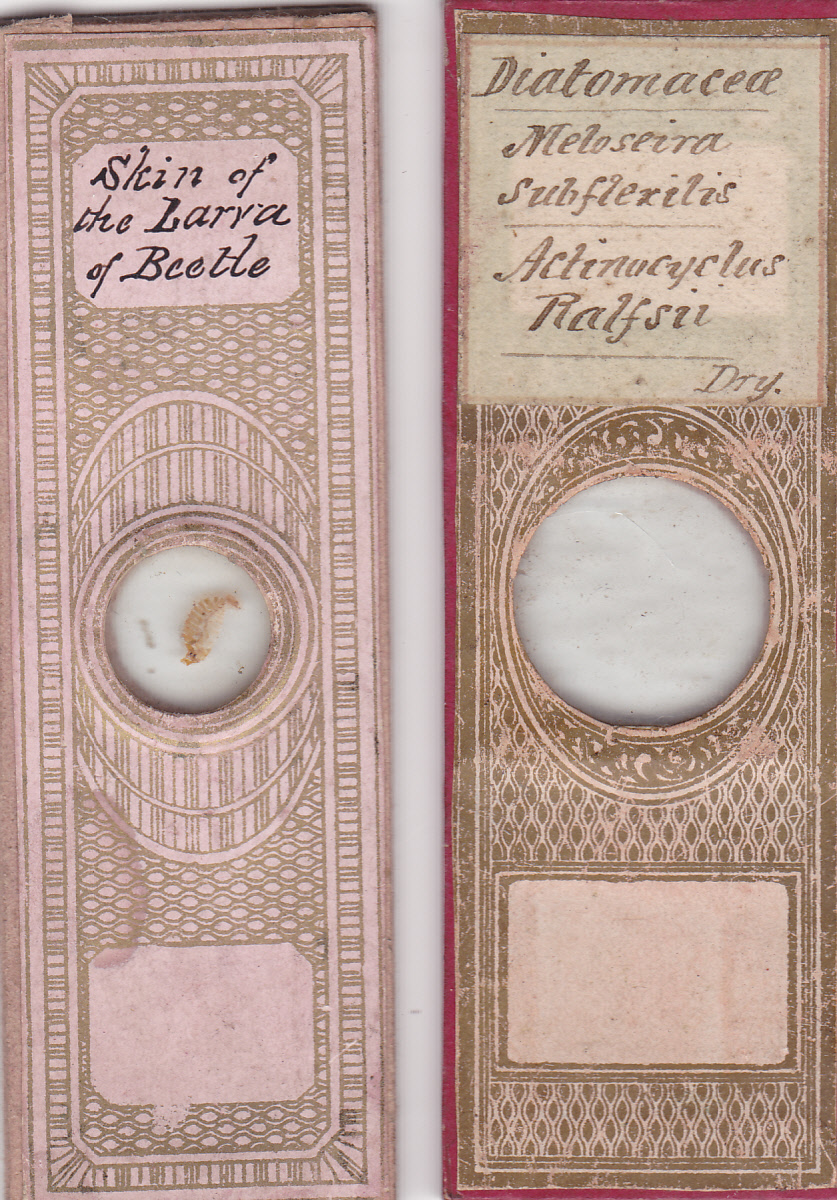
Russell slides with complete wrap-around papers.
When certain slides lacking name or label are compared to familiar Russell examples, there is not much room for doubt about who made them.

Wood sections were favourite subjects for many mounters, being fairly easy to cut and present as dry mounts. Some papered by Russell are shown below.
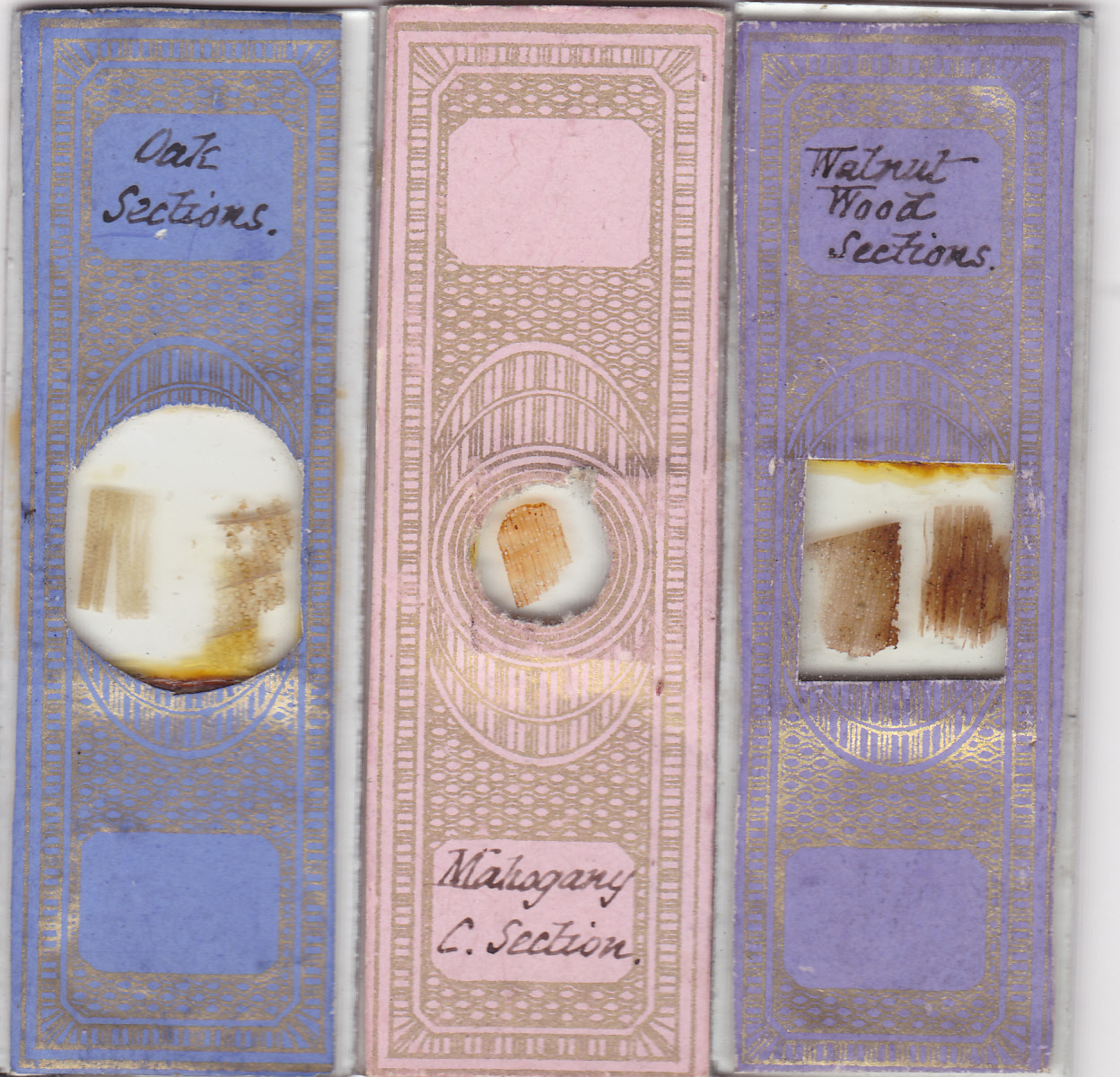
Some Russell wood mounts, papered on front only: my collection has none with three directional cut sections favoured by many mounters, but such may yet come to light.
As Brian Stevenson comments, commercial preparers show some upward social mobility in the nineteenth century. The trend was uneven – hardly any early preparers were admitted to the Royal Microscopical Society, but Arthur Cole could switch from professional organist to commercial preparer. His son Martin spent decades mounting for him, and for retailers as far away as Scotland (Angus & Co.), but eventually “made it” to an academic position. England escaped cataclysms like the French revolution, but gradual social ferment resulted in change nevertheless, just as profound. Many surgeons, for instance, remained consigned to the servants’ entrance, but some were knighted and might, like Lister, take a seat in the House of Lords. Research activity in general offered opportunities – neither Faraday nor Wallace were “gentlemen”, but by mid to late century both were household names. Commercial preparers were evidently conscious of the situation – John Barnett described himself as a “micro-anatomist” and Amos Topping assumed the title “Professor of Microscopy”. It is often assumed that “higher” men disdained “lowly” activity like slide making, but such was never necessarily the case. Quekett, and later Wyville Thomson, made many slides, and Tennant even sold commercially on a significant scale. Russell seems to have been content, eventually, with the title “geologist”.
The 1861 census shows Russell living in inner London Paddington and working as a clerk. But in 1861 he was also elsewhere, as the slides below attest.
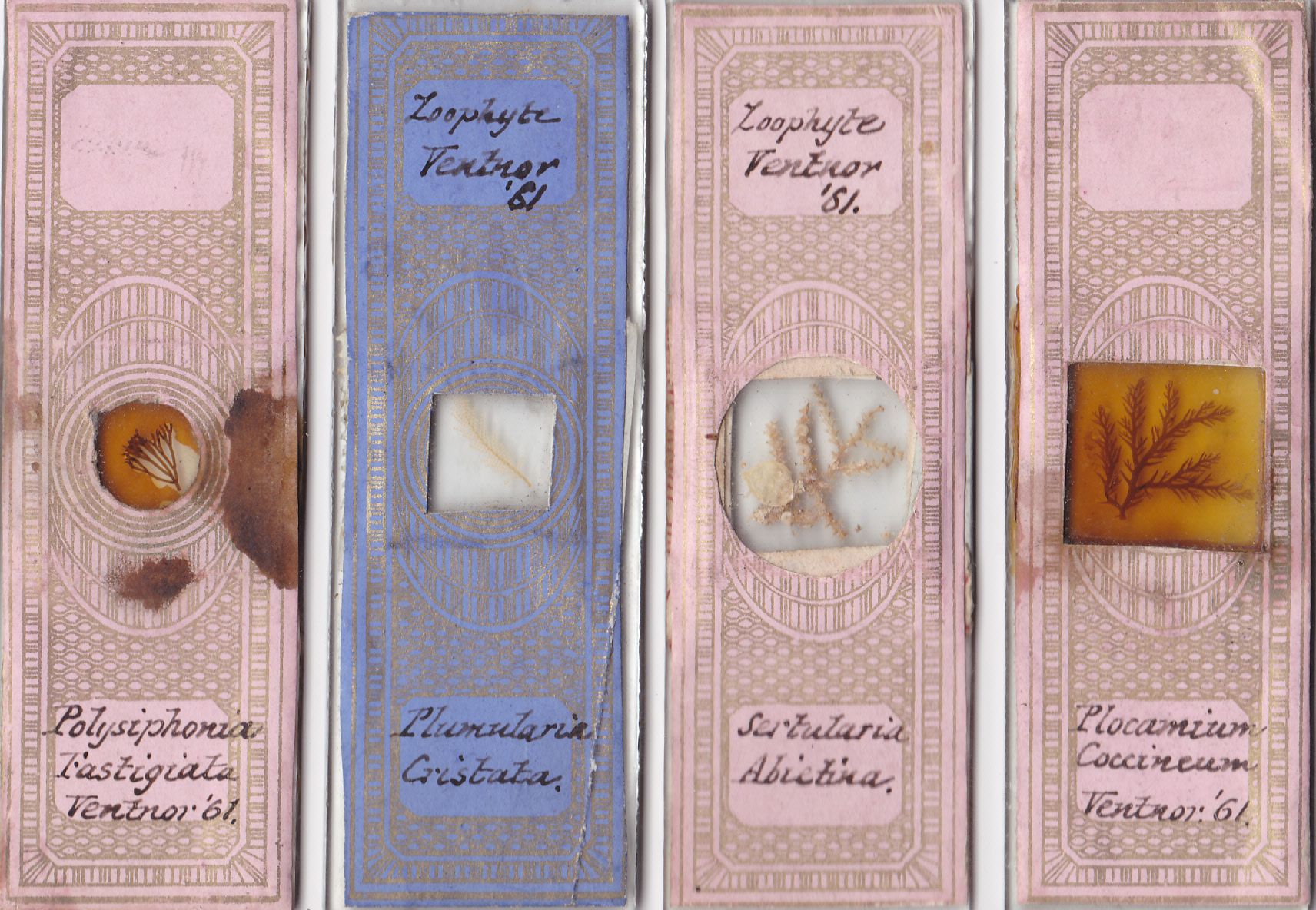
Russell slides, dated 1861, with material from the Isle of Wight.
Those slides carry only the year’s date, not the month. I suspect however that they pre-date the census. In 1861, no railway existed on the Isle of Wight: getting there from London included a sea trip, and it was not yet fashionable for holidays, as it later became when travel was easier and Queen Victoria’s residence there made it a draw card. The Russell family, even though the preparer’s father had died by 1861, was reasonably comfortably off. Ventnor was a sleepy and obscure village. Why undertake such a journey when many other locations were better appointed, and infinitely easier to reach?
Some family connection with relatives in Ventnor may have existed, but I have been unable to find any, and in 1861 Russell was not yet married. Certainly, the Isle of Wight coast contained interesting material – but so did more accessible regions. Anyone seeking commercial gain from slides was unlikely to prefer it. A more sinister reason may have taken Russell there. In 1800, most people in England had never heard of Ventnor. If Ventnor was known at all by 1861, it was for only one thing: its supposedly healthy environment for “consumptive” convalescents. Reality or not, it may have been suspected TB infection which took Russell there, probably for a fairly long stay. If he actually did contract tuberculosis, a long rest in Ventnor may have aided his recovery, since he lived until he was 90.
A boost to slide production came with expansion of universities and teaching hospital medical schools. By 1900, the student population was enormous compared to that of 1800, notably in London but in the whole UK as well. When Huxley began his career there were no British professorial chairs in biology, but by the time he retired there were scores. The largest single demand stemmed from regulation of the medical profession, ending apprenticeships and bringing apothecaries, surgeons and physicians under a single registration umbrella via recognised curricula in universities and associated hospitals. The regulatory trend engulfed pharmacy and dentistry, albeit more tardily. All this created big markets for student slides, amplified by the need to replace breakages. In 1840, thousands of slides might be required: by 1900, hundreds of thousands – perhaps more – were in demand in the UK.
A late 19h century bonanza thus existed for established preparers. The large inner London student population provided a tempting target: a good way to attract attention would have been joining the ranks of retailers. With an eye to the main chance, no doubt, Russell opened central London shops, initially just off The Strand, moving three times thereafter, always in central locations. In all probability the moves brought real estate profits.
Ironically, any windfall for mounters resulted in more obscurity. Previously, names on labels from firms like Norman, Topping or Wheeler were familiar to a large population of clients, be they the myriad members of microscopical clubs, interested clergy, university students, or others. Now however institutional slides no longer necessarily bore names or insignia of individual mounters. Collectors can still acquire slides by Amos Topping, recognisable by his handwriting, but not identified by label or name, which appear to have belonged to academic institutions. Retailers like Baker drove harder publicity bargains, and Baker labelled slide sets continued to find their way into institutions. Notably however, Amos Topping and Hinton are absent from Baker’s 1901 catalogue preparer list, although both handwritings are clear to see on Baker slide labels of the time. Russell is probably another example of the altered commercial environment, and the slides shown below may be examples.

Russell slides which may have institutional provenance. The number 94 on the kidney slide may indicate a large series for pathology students.
Nothing prevented mounters from continuing to advertise, and they could still attract custom from specialist collectors visiting strategically situated shops - Russell built a big reputation on geological slides. Experts in rock sectioning, naturally, were good mounters of fossil bone, which attracted great general interest. Dinosaurs excited public fascination, the ichthyosaurus being well known since William Buckland’s discovery. An 1830 cartoon by de la Beche satirises Charles Lyell’s ideas on cyclical geology and evolution.
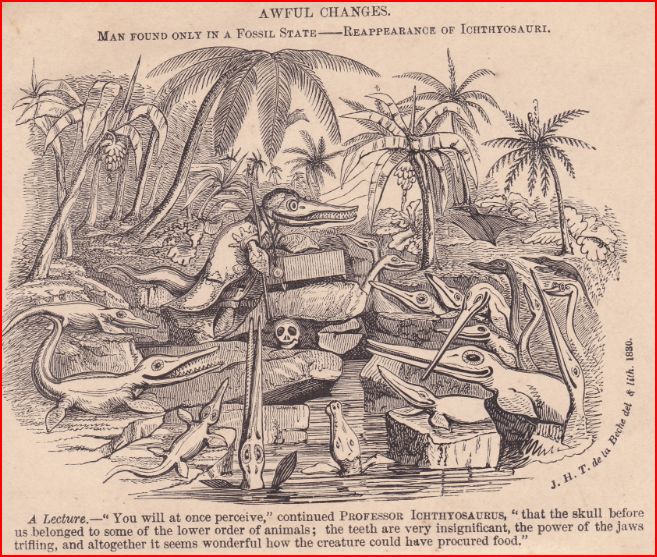
(The cartoon was unknown to the general public until Frank Buckland popularised it in 1857.)
Those who could obtain samples of dinosaur bone were assured of sales, and several mounters presented slides, including Russell.
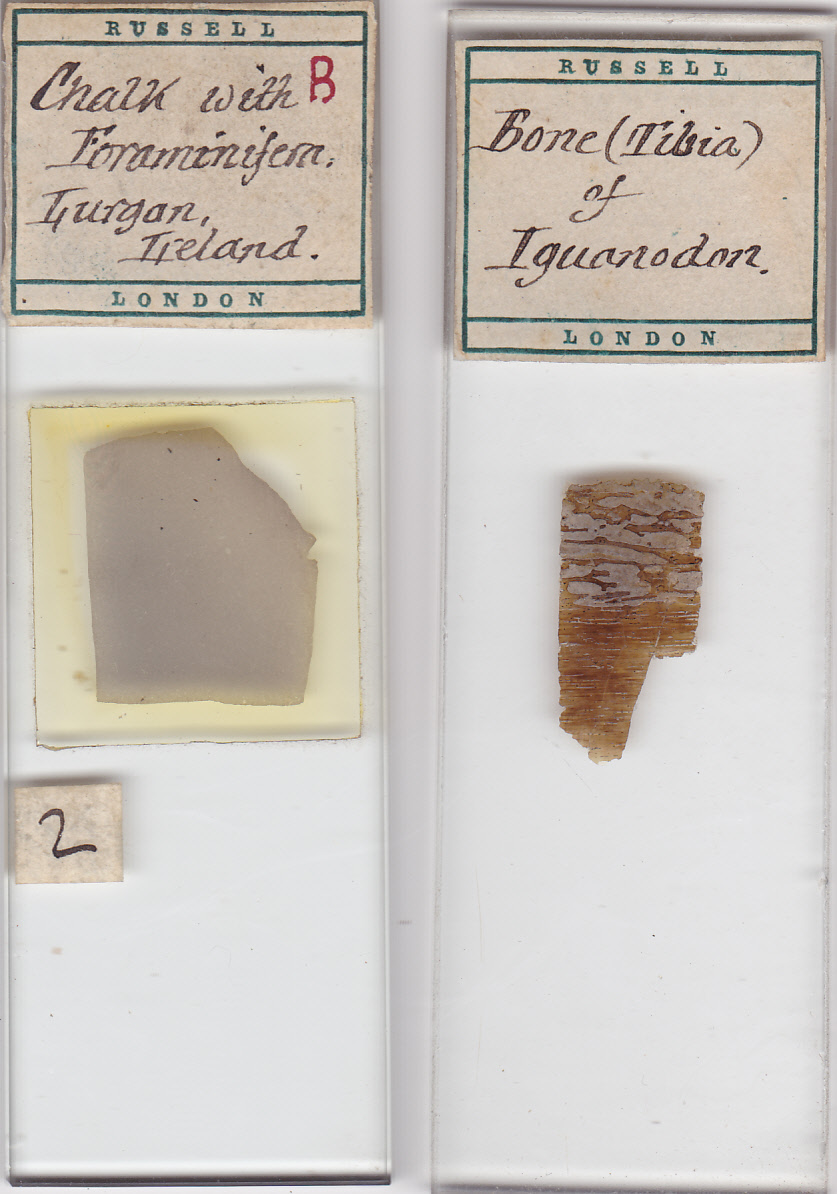
Rock and dinosaur bone mounts by Russell.
Skills in rock mounting and fossil bones were closely allied: the iguanodon created a popular sensation in the 1880s, when giant skeleton reconstructions began appearing in Brussels and then in England.
It may be that individual preparers drove their own bargains with institutions: anonymity could result in contracts from several institutions, avoiding attempts at exclusivity by buyers. Anatomical, pathological and general biological subjects, prepared for students, probably continued to provide steady income into the early twentieth century. Mounters may have coveted fame, but my guess is that – given a choice – they preferred the money.
Comments to the author will be welcomed.
Sources
1861 England & Wales census
Frank Buckland, Curiosities of Natural History (first series, 1857)
For a detailed biographical essay on Russell, see Brian Stevenson’s article at www.microscopist.net
Microscopy UK Front
Page
Micscape
Magazine
Article
Library
Published in the July 2010 edition of Micscape Magazine.
Please report any Web problems or offer general comments to the Micscape Editor .
Micscape is the on-line monthly magazine of the Microscopy UK website at Microscopy-UK .
© Onview.net Ltd, Microscopy-UK, and all contributors 1995 onwards. All rights reserved. Main site is at www.microscopy-uk.org.uk .